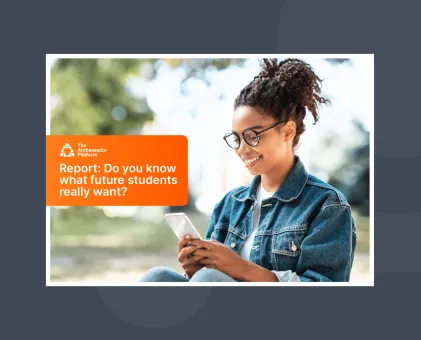How are prospective students using social media in 2024?

As universities strive to connect with prospective students, understanding where and how these students prefer to communicate and consume information is critical. In 2024, the digital landscape continues to evolve, revealing new trends in the use of social media and other digital platforms by prospective students, providing three key insights that universities need to consider for effective engagement.
1. WhatsApp, email, and university website chats: leading the way in personal connections
When it comes to establishing personal connections, web-based messaging platforms are the top choices for prospective students. Our recent survey shows that WhatsApp, email, and chats on university websites are the preferred channels for students looking to connect with real students.
- WhatsApp has seen a significant increase in popularity, growing from 43% to 61% in just one year. This rapid growth highlights its importance as a communication tool.
- Email and university website chats remain staples, providing direct and reliable means of communication.
- Online student forums are also valued by about a third of respondents, offering a space to connect and share experiences with peers.
This trend underscores the need for universities to maintain a strong presence on these platforms, ensuring they meet prospective students where they are.
2. The research process: LinkedIn's surprising popularity
Social media platforms are crucial during the research phase for prospective students. While well-known platforms like YouTube and Facebook are already integral to many universities' digital strategies, LinkedIn emerges as a noteworthy player.
- LinkedIn is used by 38% of prospective students to explore their study options. This platform’s focus on professional networking aligns with students' concerns about the return on investment and career outcomes of their educational choices.
- Despite its massive user base, TikTok appears to be less influential in the research process, suggesting that universities might be overestimating its role in their digital strategies.
Universities should consider enhancing their presence on LinkedIn to provide content that addresses career prospects and professional development, aligning with students’ priorities and perhaps consider how alumni might play a key role in their strategy on this platform.
3. Content preferences: authenticity and relatability are key
The type of content universities share on social media significantly impacts prospective students' engagement. Our survey showed that there is a clear preference for content that features real people and genuine experiences.
- Interviews and testimonials from current students are highly valued, with 50% of respondents favouring student interviews and 39% preferring student testimonials.
- Interviews with academics are also important, appreciated by 44% of students.
- Videos and student-generated content rank highly, with over 35% of students finding them valuable.
In contrast, traditional content like virtual tours, prospectuses, and blogs are less appealing to students. This preference for authentic and relatable content highlights the importance of showcasing real experiences and outcomes. Therefore, universities should focus on producing and sharing content that features the voices and stories of current students and faculty to resonate more deeply with prospective students.
Conclusion
Understanding and adapting to the evolving social media preferences of prospective students is essential for universities aiming to attract and engage future students. By leveraging popular communication platforms like WhatsApp, focusing on professional networks like LinkedIn, and prioritising authentic, relatable content, universities can effectively connect with and inspire the next generation of students.
If you want to get more insights into what really matters to prospective students in 2024, check out the full report.


